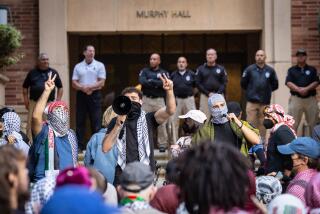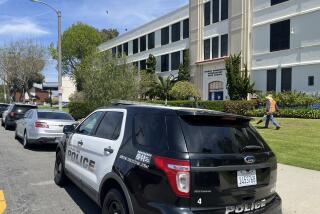A LOOK AHEAD * L.A. Unified police say they face the same dangers as other law enforcement agents and therefore need more than handguns at their side. But itâs up to the Board of Education to answer . . . : A Request to Ride Shotgun
The first call came at 8:45 a.m.: An armed robber had burst into the student store at Bethune Middle School in South Los Angeles, grabbing $2,000.
At 12:43 p.m. in the East San Fernando Valley, officers patrolling near Polytechnic High spotted a stolen Toyota Camry and gave chase, eventually cornering a 16-year-old burglary suspect in a deserted alley.
And at 3:30, another call: Less than a block from Franklin High School in Highland Park, other officers apprehended a ninth-grader with a pearl-handled .25-caliber pistol.
The responding officers werenât from the LAPD. They came from the Los Angeles Unified School Districtâs police force. And this wasnât a typical day--it was too slow.
To spend a few shifts with these officers is to witness the evolution of L.A.âs school police from night watchmen to big-city cops. Woefully understaffed, responsible for increasingly valuable property, they confront violence on a daily basis.
That escalation is a key reason for the school police forceâs controversial request to allow officers to carry shotguns in their patrol cars. Officers argue that since they have the same training as other police departments and face the same dangers, they should have the same equipment.
The proposal--to be considered by the Board of Education tonight--has put the normally anonymous department in an unaccustomed spotlight.
The school district force--the fifth-biggest police force of any kind in Los Angeles County--is the largest school police department in the nation. Its 292 sworn personnel are charged with protecting 900 sites across the 710-square-mile school district.
Its blue-and-white patrol cars and officers armed with handguns may be familiar on campuses--where 155 of them walk beats and 88 others serve in patrol units--but the department is largely unknown outside the school district.
Even as officers respond on a regular basis to drive-by shootings, armed robberies, burglaries and other crimes in neighborhoods around schools, they still are viewed by some as little more than lumbering security guards--an image reinforced by the departmentâs own beginnings as a security service half a century ago.
Yet the officers undergo the same training as all police personnel in the state and, as a series of recent ride-alongs showed, they face many of the same perils.
âPeople donât think youâre a real cop, yet when a criminal sees you, they see a cop. They donât say, âOh, youâre a school guard.â They shoot at you,â Officer Nathan Martin, a 13-year veteran, said during a graveyard-shift inspection of Jefferson High.
Department statistics show that weapons-related crime on campuses has been on the wane--from 1,403 reported incidents in 1991-92 to 1,001 in 1995-1996.
*
But much of the violence seems to have spread into surrounding neighborhoods, where students--often armed--sell drugs, pick fights or wind up as victims themselves. In the last three months alone, four students have been killed just off-campus, three of them while walking home from campus.
Often, the first to arrive on the scene are not city police or sheriffâs deputies but nearby school police.
Franklin High campus Police Officer Leticia Valencia was responsible for spotting the ninth-grader with the pearl-handled pistol and shaved head two Fridays ago. She watched the boy--a known member of the Drew Street Avenues gang--pick up what appeared to be a gun from the pine brush across the street from school just after classes were dismissed for the day.
Valencia radioed for help. Three school patrol cars circling the campus converged on the Franklin student and two friends as Valencia watched the ninth-grader toss what she thought was a gun onto a sidewalk. The officers ordered the trio to the ground face-first and handcuffed them.
âWhere you from?â Officer Kevan Otto asked the 15-year-old.
âNowhere.â
âWhy you lie to me like a chiquito? You got any bazookas on you?â
Franklin Principal Sheridan Liechty hurried to the scene, a walkie-talkie in one hand and a pained expression on her face.
âIs that a real gun?â Liechty asked.
âItâs a real one,â Valencia said.
âDoes it have bullets in it?â
âFully loaded with a bullet in the chamber,â Otto said, as he gingerly removed the magazine from the gun.
The boy, dressed in a black hooded sweatshirt and baggy pants, was packed into the back of the L.A. Unified patrol car and booked for possession of a handgun--a felony because it was within 1,000 feet of a school. His two friends were released after officers collected their names and addresses on field identification cards.
The incident was routine for officers who spend much of their time stopping suspected gang members--searching, questioning, running names through dispatch for outstanding warrants.
Often, it lapses into a game of cat-and-mouse--a game that Otto, a former Army infantryman who joined the school police five years ago when the Los Angeles Police Department had a hiring freeze, is determined to win.
Just two hours earlier, Otto had rolled up on four teenagers who were walking along the sidewalk outside Belmont High. School was in session. Checking for truancy, Otto asked for IDs.
âWhy you harassing me?â asked one 19-year-old in the group when Otto began questioning and searching him and his friends. âEvery time I go to school, I get stopped.â
*
Verbal defiance landed the youth in handcuffs. Otto ran his name for outstanding warrants. Nothing. The group was released.
Not everyone agrees such field inquiries are valuable, and some question whether they are civil rights violations.
âWhat troubles me is if there is a pattern of stopping kids after school hours for no [clear] reason,â said Elizabeth Schroeder, associate director of the American Civil Liberties Union of Southern California. âIt appears as if the police are singling out kids, violating their constitutional rights and doing so with an expectation that these children are the least powerful in society.â
District officials said that a âhandfulâ of complaints had been lodged over the last five years, but they could not say precisely how many. âThey have been very few and far between,â said Richard Mason, the districtâs general counsel.
Itâs easy to mistake school police for the LAPD.
Officers from both departments wear gold-and-silver badges and carry 9-millimeter Beretta pistols. The deep blue uniforms of the school force are virtually the same shade as the LAPDâs outfits.
The similarities go beyond the cosmetic.
Nearly all of the school districtâs officers attend the Rio Hondo Police Academy in Whittier, the same facility that trains police for many departments across the county, including those in Burbank, Glendale, Pasadena and Beverly Hills.
While the state requires a minimum of 664 hours of academy training for peace officers, L.A. Unified personnel undergo 800 hours; LAPD officers get 1,064 hours.
School police also have to meet the same state minimum hiring standards that require extensive background checks, physical and psychological exams, written tests and oral interviews.
They are empowered to make arrests not only on school property but anywhere in the state, and refer their cases to prosecutors. Suspects taken into custody are driven to the nearest jail.
Officers say the 75 shotguns the department wants to buy for its patrol cars are a necessity for a job that can turn deadly at any moment. With its spreading load of pellets or balls, the shotgun increases the shooterâs chances of hitting a target at short range, although the shot loses velocity and falls to the ground within a few hundred yards. Pistols, on the other hand, are more lethal at longer distances but require greater control to fire accurately.
*
School Police Officer James Ream sees the sheer size of the shotgun as a psychological deterrent that could save lives in one of the most common and hazardous tasks of the job: traffic stops.
In one recent incident, Ream approached a car blocking a traffic lane near North Hollywood High. Five youths sat inside and two teenagers leaned into the passengerâs side window. As Ream pulled up, the car sped off and the two teenagers outside took off running.
A chase ensued until the car pulled over and the occupants fled on foot. Ream caught up with the driver, recovering a loaded 9-millimeter pistol. Another officer picked up one of the other occupants and recovered a knife.
Ream said deploying a shotgun during the initial traffic stop would have kept the teenagers from running and would have given him more protection.
âIâd like to have that shotgun in case they have in mind shooting me,â he said. âIf I have that shotgun, those guys are a lot less likely to come at me.â
The force deploys just 31 patrol units during the day, about 10 on the swing shift and four to five on the graveyard watch. It can take 10 or 15 minutes for backup units to arrive at night because of the thin numbers.
*
Graveyard is a spooky, forsaken shift, when a shadow can spike the nerves and the sudden activation of a campus power generator can stiffen the hair on the back of the neck. This is the time when burglars and vandals clamber into schools and make off with petty cash, televisions, computers and VCRs--the trappings of a technological age that make schools ever more vulnerable targets. Every cracked window, every unlocked gate can mean an intruder hiding in the dark.
On a recent night, Officers Nathan Martin and Jim Conner, usually assigned to the Valley, quietly made their way through pitch-dark campuses in South Los Angeles, their path illuminated only by the dull glow of the distant downtown skyline.
They were searching for the âSecond-Floor Banditâ--a burglar who shimmies up drain pipes, enters second-story windows and ransacks classrooms. âThe guy is in and out in two to three minutes,â Conner said. âThe guy is slick.â
Just after 12:30 a.m., the call came over the radio: a Code 30--silent alarm--in the second floor of the administration building at 66th Street Elementary.
Martin and Conner pulled up to the school, and Martin dug through the clutch of school keys loaded in the trunk. He unlocked a thick steel chain and they quietly entered the campus, shining their flashlights on second-story ledges and windows.
The pair approached the front door and Martin slowly inserted the key. The unlocked door creaked. The officers winced. Then they entered the building with their flashlights shoulder-high.
They found nothing out of place. A false alarm--perhaps a rat or a delivery person set off the motion detectors.
âCode-4 this baby,â Conner said, meaning the building was secured, as the pair flipped the lights in the main office.
They climbed back into their patrol car. Moments later, another silent alarm. They sped into the night to repeat the drill.
More to Read
Sign up for Essential California
The most important California stories and recommendations in your inbox every morning.
You may occasionally receive promotional content from the Los Angeles Times.










